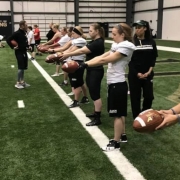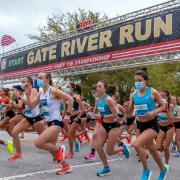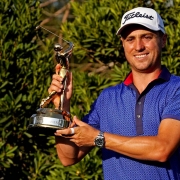Women Kickers In Football
It never took long in any conversation with Tom Coughlin about the kicking game for the Jaguars Head Coach to explain something about Mike Hollis.
“He’s not just a kicker,” Coughlin would say, “He’s a football player.”
That says a lot about kickers as outliers on any football team, but also says plenty about the Jaguars placekicker from 1995-2001.
“I’m 5’7” and 180 pounds” Hollis said this week. “So, my size, my weight and my lack of freakish athletic ability necessitated me having a certain technique to compete.”
Hollis held several Jaguars franchise records, was the leading scorer in the NFL in 1997 and selected to the Pro Bowl the same year. For about a year and a half during his eight-year NFL career, Hollis was the most accurate kicker in league history.
For the past fourteen years, Mike has run the ProForm Kicking Academy, tutoring mostly local kickers on the finer points and the technique that results in the ball going through the uprights.
“I didn’t have a goal to play in the NFL,” Hollis recalls. “I just wanted to try and be as good as I could.”
By using his technique, he distills down to two words, “forward momentum,” Hollis was able to compete at the highest level. Some of his students have gone on to college careers and even a shot in the NFL.
This weekend, Mike and several other nationally prominent coaches are holding a kicking camp at Davis Park for a specific group that has recently showed an interest in becoming kickers: Women.
“Naturally women aren’t as strong as men so giving them my form and technique gives them an advantage,” Hollis explained. “Plus, I’ve found women to be better listeners in general.”
“I’ve progressed a lot,” said Ellie Wilhelm, a junior at Bishop Snyder High School who has been the Cardinals kicker for the past two years. “I was originally kicking about 25 yards. I started learning the form for kicking and started training with Mike. I’ve probably gained 20 yards.”
Wilhelm is a three-sport athlete at Snyder, a midfielder and the backup goalkeeper on the soccer team and competes on the track team in the spring. She’s no different than most of Hollis’ other female students with a background in soccer and in interest in football.
“All of the women I’ve coached have come from soccer,” Mike explained. “Parents and peers also have brought football to their attention. I want to teach these girls a way and a different thought process about kicking. I want them to understand the process of getting the best out of them.”
If there is one difference about Ellie, it’s that she loves football.
“I’ve been watching football since I was little with my dad,” she explained. “My gym coach in high school is actually the head football coach. I played some flag in class and he mentioned that I should come play for the school team. I love football.”
Katie Hnida, April Goss and most recently Sarah Fuller at Vanderbilt are women who have kicked and scored in college football and Wilhelm wants to do the same.
“It was exciting to see Sarah Fuller kick this year,” Ellie said of Fuller being the first woman to score a point in a Power 5 game. “She’s the keeper (on the soccer team) and that resonated with me so much. She just went out there and did what she wanted to do.”
“I’d like to kick in college,” Wilhelm admitted. My goal is to play and kick in college. I’d like to earn a spot. I love football and I’d like to be in the NFL.”
Using his technique while building strength and through practice, Hollis believes there are plenty of women who can become effective kickers. And as a father of a daughter and a son, Hollis wants to see women have a chance.
“We want to promote women in sports, It’s a great thing,” Mike said. “There are girls that play soccer and have a knack for kicking, if they don’t feel odd about playing on a boys’ team, most of them say ‘I want to be a kicker, I don’t care what the boys think.’”
“It doesn’t faze me anymore,” Wilhelm said of being the only woman on the field. “There are some girls on the other teams we play. There was one girl who was a linebacker. It’s not crazy anymore, we don’t care. It’s just a sport to me, whether it’s the boys’ team or not.”
Furthering a career in football for women can be difficult. You might remember the Dixie Blues, a local women’s team that plays in the Women’s Football Alliance an organization that bills themselves as the “World’s Largest Premier Women’s League.” They’ll enter their nineteenth season of play in 2021.
Former Arlington Country Day football coach Terry McGriff coaches the North Florida Pumas, part of the Women’s Tackle Football League. McGriff says they have seventeen teams from Washington state to Palm Beach and plan to start playing in May of this year.
“We want good, competitive games,” McGriff said, noting they have about twenty players now and will eventually cap the roster at thirty-five. “These women want to be out there so they’re easier to coach, they ask more questions. They want to know why.”
And while he says teaching women the basics of football is easier because “they don’t have bad habits to break,” McGriff also believes there is a bigger life skill for women learned through football.
“It can be a violent world out there,” he noted. “And this is a way women can not be intimidated by that. They understand how this can be part of their daily life. To be aware of their surroundings and what’s going on.”
But for this weekend at Davis Park (9-1pm today) it’s about kicking and technique, forward momentum and getting the ball through the goal posts.
“There are a lot of physics that go into kicking,” Wilhelm noted. “You have to get swing and technique. I have more confidence.”
Which sounded a lot like her teacher’s philosophy.
“It sounds funny, but I tried to not care where the ball went,” Hollis once told me about going onto the field for a kick. “I was thinking, ‘If my technique is right, the ball is going to go where I want it.’ Once you get that trust in your technique on game day, that’s the greatest feeling.”
For more information about kicking and women in football you can check out ProFormkicking.com, LacesOutFoundation.com, NFPumas.com or dixiebluesfootball.com





